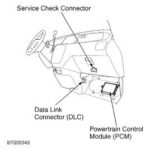It’s a common scenario: your check engine light was on, you addressed the issue, and now you’re heading for a vehicle inspection. You might assume that clearing the trouble codes is enough to pass. However, you might be surprised to learn that your car can still fail inspection even without the check engine light illuminated. This is often due to OBD2 readiness monitors not being in a “Ready” state, even after driving.
To pass an emissions inspection, your vehicle’s On-Board Diagnostics system, specifically OBD2, needs to confirm that all emission-related systems are functioning correctly. This is done through a series of self-tests performed by internal monitors. These monitors, typically eight in number, assess components like the catalytic converter, oxygen sensors, evaporative system, and more. For your car to pass inspection, these monitors must report a status of “Ready” or “Complete.” If any are marked as “Not Ready” or “Incomplete,” it indicates that the system hasn’t finished its self-tests, and your vehicle will likely fail the emissions test.
Simply disconnecting your car battery to turn off the check engine light, while effective in erasing codes, also resets these readiness monitors to “Not Ready.” To set them to “Ready,” you need to perform a drive cycle. A drive cycle is a specific driving pattern that allows your car’s computer to run all the necessary diagnostic tests. This typically involves a combination of city and highway driving conditions, including varied speeds, acceleration, deceleration, and idling periods.
Even after driving, you might find that some OBD2 monitors remain stubbornly “Incomplete.” This can be frustrating, especially when you believe you’ve resolved the underlying issue. There are several reasons why your OBD2 monitors might not be setting to “Ready” despite driving what you believe is a sufficient distance:
- Insufficient Drive Cycle: You might not have completed a full or correct drive cycle for your specific vehicle make and model. Different manufacturers have slightly different drive cycle procedures. Consulting your owner’s manual or a repair manual for the specific drive cycle for your car is crucial.
- Underlying Issues Still Present: Even if the check engine light is off, a minor or intermittent issue might still be preventing a specific monitor from completing its test. For example, a slightly aging oxygen sensor might function most of the time but fail the diagnostic test during certain driving conditions.
- Specific Monitor Requirements: Some monitors, like the evaporative system monitor, have very specific criteria to run, such as fuel tank level, ambient temperature, and engine temperature. If these conditions aren’t met during your drive, the monitor won’t run its test.
- OBD2 System Problems: In rare cases, there might be an issue with the OBD2 system itself, preventing monitors from running or reporting correctly.
It’s also important to remember that sometimes, a persistent check engine light and related codes might not indicate a severe mechanical problem that affects vehicle performance. For instance, the author of the original article describes a recurring P0420 code (catalytic converter efficiency below threshold) on their older Chevy Impala. Despite replacing the catalytic converter twice and testing oxygen sensors, the code kept returning. However, the car’s performance was normal. In such cases, completing a drive cycle after clearing the code becomes a necessary workaround to pass inspection, even if the underlying code might reappear later.
To check the status of your OBD2 monitors, you’ll need an OBD2 scanner. These scanners are readily available and can plug into your car’s OBD2 port, usually located under the dashboard. The scanner will display the status of each monitor, indicating whether they are “Ready” or “Not Ready.”
In conclusion, while driving your car is essential to set OBD2 readiness monitors, simply driving around might not always be enough. Understanding the concept of drive cycles, ensuring your car meets the conditions for monitors to run, and using an OBD2 scanner to check monitor status are all crucial steps to ensure your vehicle is ready for its emissions inspection, even if you experience persistent OBD2 issues despite regular driving.

